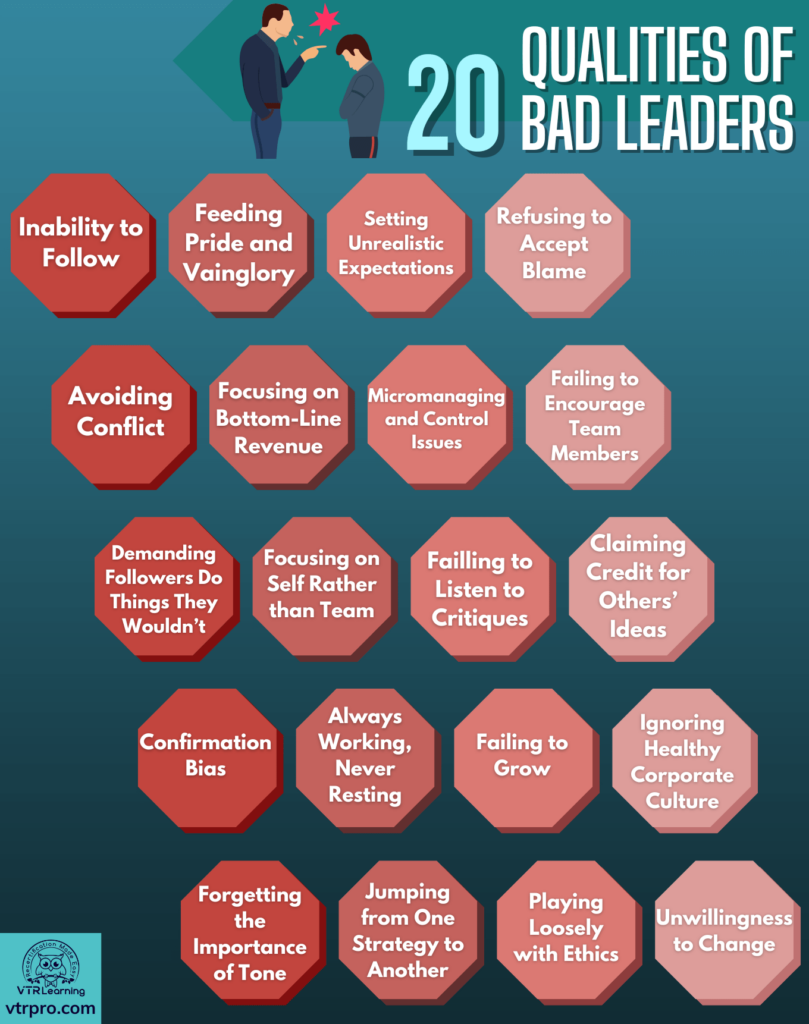
If you’ve ever worked for someone else, you probably have an idea of what makes good and bad leaders. But here’s the thing — leadership isn’t easy. It’s simple to say, “I could do this better”. But putting words into practice is far more difficult. Just because someone can theoretically manage a team doesn’t actually make them great for the job. And it’s just as important to recognize patterns to avoid as it is to emulate good characteristics. So, if you’re looking to head up a team in any capacity, pay attention to these qualities of a bad leader.

Share this Image On Your Site
Stay Away from These Qualities of a Bad Leader
1. Inability to Follow
How difficult it must be to lead well whenever you’ve never followed another person in your life. Good team management requires genuine experience as a follower. Because without this background, it’s difficult if not impossible to empathize with your workers or to know what to expect from them. More importantly, the best leaders know when to take a step back and allow others to pave the way when experience or expertise in an area exceeds their own. So, they must be willing and ready to lead through followership whenever necessary. Remember, good leaders are often good followers.
2. Feeding Pride and Vainglory
“Vainglory” isn’t a word most people are used to hearing today, but it is as prevalent a vice as ever. If pride is the inner belief that you’re better than others, vainglory is the drive for public recognition above all else. In other words, it’s excessive vanity. And this is one of the easiest traps for leaders to fall into. When you’re heading up a successful team or organization, it’s tempting to take the credit and step into the spotlight. But effective leaders must be aware of these tendencies and stay humble. Because if pride and vainglory are fed, they can lead to loss of respect and trust. After all, followers aren’t stupid — they can tell when they’re being used to boost another’s ego.
3. Setting Unrealistic Expectations
Few things feel worse to hard-working teams than failing to meet the expectations of their leaders. After all, when you’ve poured in blood, sweat and tears, it’s natural to hope your goals are attainable. But one of the qualities of a bad leader is setting expectations that teams could never hope to achieve. This practice can inflict far-reaching damage on both leaders and workers. Because managers anticipate a result that will not happen the way they hope. And followers are burdened with the expectation to achieve something highly unlikely. This can lead to conflict, disillusionment and distrust. So, it is important for leaders to pay attention to to conditions of the market and set realistic expectations that can be met.
4. Refusing to Accept Blame
You’re probably aware of the idea that the captain should go down with the ship. It’s a leadership principle that hallmarks effective managers. Because just as team heads should be celebrated for their contributions to success, they must accept blame when things go wrong. After all, they are responsible for ensuring goals are met appropriately and efficiently. So, when they aren’t, they should be the first to accept blame. When leaders fail to do so, workers are quick to notice. And as with other qualities of bad leaders, failure to accept blame can lead to long-lasting feelings of resentment. Good leaders must never expect their teams to bear the consequential weight of their own personal failures.
5. Avoiding Conflict
Generally, managing conflict isn’t something most people look forward to. It’s messy and emotionally draining. But for leaders, it’s something that simply has to be done — there’s no exception. Because whether your workers have a problem with you or one of their peers, conflict gets in the way of goals. When leaders ignore conflict because they’re afraid to deal with it, feelings of resentment boil over and spill into productivity. But more importantly, conflict avoidance makes it seem as if leaders don’t care about their teams on a personal level. In effect, it’s the same as saying, “I don’t care what your feelings are. Just get the work done.” And as any healthily functioning HR department can point out, this is a terrible practice. Ignoring problems can seem helpful at first, but the longer conflict simmers, the larger the explosion will eventually be.
6. Focusing on Bottom-Line Revenue
Just as there’s more to life than money, there’s more to business than bottom line finances. And refusing to believe otherwise is one of the most visible qualities of a bad leader. Of course, it should go without saying that money is important to a business. Without it, operations would stall and functions would cease. But when leaders focus exclusively on revenue to the detriment of all else, they risk alienating the workers they need most. Employee satisfaction and happiness are just as important to the bottom line as the work itself. Because if leaders drive away the best talent by focusing on the wrong areas, they’ll lose out on much more than just money.
7. Micromanaging and Failure to Relinquish Control
It is vital for leaders to know they can trust the teams they’ve put together. And giving your employees the space they need to effectively complete their work is a primary way of showing this. Though some employees need direction at every step of a process, this is completely inefficient. The way to know that your team is capable is by allowing them to carry out their individual duties without constant input. And this is where many managers fail. Leaders who micromanage or have trouble relinquishing control only prove that they don’t trust their teams to do the things they recruited them to do. This contributes to feelings of resentment and inadequacy that are extremely difficult to overcome if left to grow. So, good leaders must trust that they’ve formed effective teams which have the ability and knowledge to work well without constant instruction.
8. Failing to Encourage Team Members
The best leaders are often ones which care about their team members. And an important part of a good culture is encouragement. Out of the many qualities of a bad leader, this one might be one of the easiest to fix. Because it simply requires leaders to take a step back and recognize when they’re being overly critical. Of course, good managers must notice, point out and find solutions to problems. But if that’s all workers ever hear, it can be easy to stop trying altogether. Because, let’s face it — who wants to put in effort when the only things ever noticed are problems? Offering personal and honest encouragement to team members is the appropriate balance to critique. And honestly, it just feels good to recognize individuals who work hard and succeed.
9. Focusing on Self Rather than Team
This characteristic is something of an amalgamation of others mentioned so far. It’s the ugly combination of vainglory and refusal to accept blame. But it’s always been an issue for leaders and followers alike. Because the natural human instinct is to focus on self above others. That’s why we have precepts like the Golden Rule. They cause us to stop and think what impact our actions could have on others. But even as prevalent an issue as this is, good leaders must attempt to overcome it. This means recognizing personal tendencies toward self-congratulation and personal ego. And importantly, it revolves around recognizing the worth and contributions of those who follow you. Leaders who are able to focus on their team rather than their own gratification take a massive step toward a healthy management dynamic.
10. Failing to Listen to Critiques
No person is perfect, and by extension, no leader is either. Even the best make mistakes and fail sometimes. But learning from these missteps is part of personal and professional growth. So, when followers bring critiques or concerns to their leaders, they would do well to heed them. Of course, not every problem can be fixed, and some might simply have to be tolerated. But any person who refuses to listen to advice that could make them better does so to their own detriment. And that’s why failing to listen is one of the qualities of a bad leader. In harsher language, those who don’t take their followers’ concerns into account don’t deserve to lead.
11. Claiming Others’ Ideas as Your Own
It might not always be intentional, but claiming others’ ideas as your own is a prime quality of bad leadership. Because, in the best sense, it constitutes a failure to listen. And in the worst, it means the manager has knowingly stolen the recognition another individual should have received. And besides, the role of a manager is not always to come up with ideas for growth and success. It’s to facilitate a team of workers who can make those ideas come to life. So, whether an idea originates with a manager or worker, the real focus shouldn’t be on the idea itself. Instead, it should be on the tasks and responsibilities needed to carry it out. And in this sense, leaders and teams share success and failure.
12. Rejecting Any Perspectives that Don’t Align with Your Own (Confirmation Bias)
Confirmation bias is a plague to people no matter whether they’re in leadership positions or not. The tendency to reject any perspectives that contradict one’s own is a worldwide phenomenon. The problem is, most people don’t even realize when they’re doing it. So, the answer to is be cognizant of personal ideas and thoughts, then purposely seek out individuals and research that take a different stance. Because in doing so, leaders will constantly be challenged and have to defend their positions. Sometimes, this might make them more entrenched in their ideas. But other times this can help them see the weaknesses in their perspectives. And in both instances, it can inspire growth and confidence moving forward. Just because this trait is common to all people doesn’t mean it isn’t one of the qualities of a bad leader. So, where it exists, it should be rooted out.
13. Constantly Working and Never Resting
“If you don’t work, you don’t eat.” Some people take this phrase to the extreme and think they should never stop working. But the mental and physical toll this mindset takes is extremely detrimental, especially for leaders. Because the longer someone thinks this way, the more guilt they will feel whenever they do take a break. Inevitably, people can’t keep going forever. So, whenever the crash comes, it could be a complete burnout that sends the team tail-spinning. Or, it could have any number of other consequences, from internecine conflict to preventable injuries. So, it is important for leaders to recognize the benefits of rest and take those opportunities when appropriate.
14. Failing to Grow
Leadership isn’t a static role. It isn’t possible to lead well while never advancing in your understanding. Because, as we should all know, people aren’t perfect. Leaders can always find something to improve on, and any who say otherwise are only fooling themselves. So, whether this means taking the time to enroll in professional development courses or doing some research on the side, managers should always seek opportunities to learn more.
15. Failure to Create a Healthy Corporate Culture
People want to work for those who respect their time, needs and goals. And creating an environment that takes these things into account is increasingly a staple of good leadership practices. Managers are responsible for facilitating healthy working environments both physically and mentally. And failing to do so is often portrayed as one of the worst qualities of a bad leader. Just take Amazon, for example. It’s been billed for years as one of the largest companies with a detrimental work culture. And whether or not that’s actually true, the mere perception of having a negative culture can be extremely damaging. So, both at the team and organizational levels, leaders must attempt to establish healthy corporate values.
16. Expecting Others to Do Things They’re Unwilling to Do
It is entirely acceptable for leaders to expect their workers to do things that they don’t have the ability to do. After all, no one can be an expert at everything. Companies are premised entirely on that idea, because teams are made up of different people with different skills. However, leaders must never ask anyone to do something that they are completely unwilling to do themselves. Making such a demand is like saying, “Doing this is beneath me, and so are you.” That type of request is demeaning. And it’s also a great way to exemplify a lack of leadership ability. So, if this is one of the qualities of a bad leader you struggle with, it should be rectified immediately.
17. Forgetting the Importance of Tone
It’s not always what you say that matters but how you say it. And this is something leaders must be mindful of. Because you can have the best intentions and still come across as a jerk. Of course, tone plays into every interaction between managers and employees. Whether it’s conflict resolution, job performance surveys, or a quick comment at the water cooler, the way things are voiced has impact. This doesn’t mean leaders must sound “happy” all the time. Doing that would come across as fake. But it does mean they should at least be aware of the way they speak to others, particularly in situations where the wrong word could mean lasting damage. In that sense, leaders not only invest in healthy relationships with their employees by paying attention to tone. They also hedge their own professional standing.
18. Jumping Wildly from One Strategy to Another
Most managers are aware that they’ll encounter failed strategies. Sometimes, their ideas don’t work out for one reason or another. And sometimes, the best thing to do is switch gears. But leaders should be careful in these situations not to abandon a plan before it’s had time to breathe. Maybe a better piece of advice for this point is to learn patience. Because winning strategies don’t always take off overnight. It’s tempting to pull the plug on a tactic that doesn’t immediately bear fruit, but leaders must resist this urge. If they don’t, followers may perceive them to be unstable and could lose faith. So, make sure only to switch strategies when the need to do so is obvious.
19. Playing Loosely with Ethics
Maybe this point goes without saying. But judging by the number of leaders who still fall prey, it needs to be pointed out. Any time leaders skirt ethics and try to take a shortcut to success, they risk legal and professional consequences. And sure, defining ethics might be something best left to philosophers and social researchers. But most businesspeople know when they’ve crossed a line they shouldn’t have. For truly sustainable business, leaders should operate within ethical confines. And if nothing else, they should never ask followers to do differently. Because when the hammer falls, it could come down on all of them. Let’s put it simply. Good managers should care about their followers, and asking anyone to do illegal or unethical things is one of the defining qualities of a bad leader.
20. Unwillingness to Change
I put this characteristic last because it’s the one which all others hinge on. If any of the above qualities of a bad leader apply to you, the first thing standing in the way is unwillingness to change. Good leaders must be willing to acknowledge their faults in order to learn and grow from them. And honestly, the concept is pretty simple. No single leader has all the answers. And in order to become better, everyone has to embrace change.
Is It Possible to Overcome These Qualities of a Bad Leader?
Admittedly, this list of characteristics is pretty overwhelming. With so many different ways to be a bad leader, is it even possible to know how to be a good one? Don’t worry — it’s always possible to take steps to become better. One great place to start is with the LeaderDNA quiz from MTD Training Group. Essentially, this resource can help point out the areas of leadership you might personally be weaker in or struggle with. Then, once you’ve recognized those areas, VTR Learning can help, with a series of courses dedicated specifically to the subject of leadership. So, if you’re wondering how to grow into the leader your team needs you to be, there are plenty of resources out there that can help you in your journey.
Last Updated:





